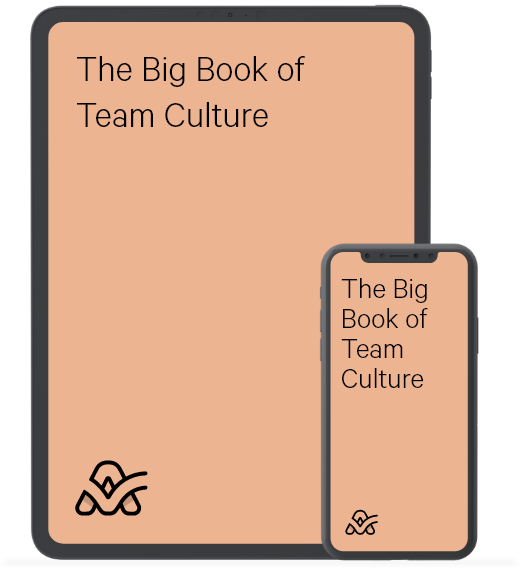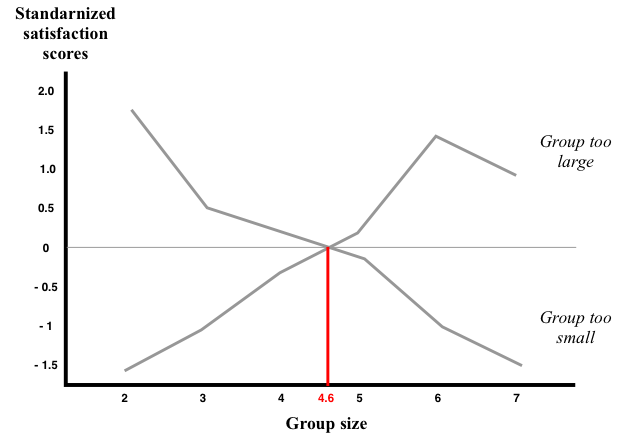Did you know that a perfect, productive team has exactly 4.6 members, eats two pizzas for lunch, and consists of people that call themselves “the raiders” or “the oogie boogies”?
How team size impacts team productivity
The larger the team, the less productive they are:
Large-size teams encounter more problems of absenteeism and turnover, members are less satisfied with their work, they experience more negative emotions, and they have lower level of mental health. When it comes to productivity and number of members of the team, less is more. - Group Dynamics: Theory, Research and Practice

The Big Book of Team Culture
An ideal team has 4.6 members (according to research conducted by Hackman and Vidmar).
In order to determine how team size impacts processes and performance on different kinds of tasks, researchers formed groups that varied from 2 to 7 members. After completing their duties, all group members were asked to answer two questions:
- Was your group too small for the tasks at hand?
- Was your group too large for the tasks at hand?
The chart below is a graphical representation of average answers to these two questions. The point where two lines cross represents an optimum size of a productive team, which is 4.6 members.

To determine whether your team is too big, you can use the simple "two-pizza" rule:
If you can’t feed a team with two pizzas, it’s too large - Jeff BezosJeff Bezos found that teams that consist of 5-7 people (who you can feed with two pizzas) are more autonomous and tend to come up with more innovative solutions.
In both theory and practice shows that smaller teams are more productive than the large ones, with benefits like more effective communication, greater trust among team members, and less fear of failure.
Another benefit of small teams is the avoidance of groupthink and social loafing.
Groupthink usually occurs when people within the group choose to neglect rational or optimal solutions, for the sake of maintaining harmony within the team, where creativity, independent thinking is neither wanted nor encouraged.
The real problem with groupthink is that projects are more likely to end up in failure because no one wants to think critically and propose how to fix bad things.
Then we have social loafing, which doesn’t result in bad decisions, but can cause discord in a team. Social loafing usually occurs when one or several members try to get by with the least amount of work possible, transferring most of the responsibility onto the rest of the team. This free-rider effect can further trigger the sucker effect, where overloaded team members lower their efforts on purpose as a response to free-riders.
Also, there is a danger of creating in group who works hard and out group who's slacking. This creates resentment between them, cause emotional tension, and result in low productivity.
So what is the best size for a productive team? An odd number close to five. Why an odd number? Simply because there is no danger of getting a tie when it comes voting.
Jelled Teams
A team that lacks cohesion and synergy cannot reach its maximum productivity. In fact, it would be miraculous if it achieved any productivity at all.
A jelled team is a group of people so strongly knit that the whole is greater than the sum of the parts. Once a team begins to jell, the probability of success goes up dramatically. They don't need to be managed in the traditional sense, and they certainly don't need to be motivated.” - T. DeMarco & T. Lister
Once members reach synergy and understanding, the team doesn’t magically get lit up with a big “JELLED” neon sign above them. In fact, there is hardly any indication that jelling has occurred.
The best indicator of jelling is low or non-existent turnover. Also, in jelled team factors like money, status, or possibility of advancement matter less - it is all about achieving common goals and having a blast with your friends while doing it.
Jelled teams usually have a strong sense of identity and even colorful names, like the "Okie Coders" at General Electric; the "Gang of Four" at DuPont; the "Chaos Group" at Cincinnati Gas & Electric.
All members in jelled teams share private jokes, catchphrases, and often get together after work.
You can’t just create a Jelled team. According to study managers cannot simply make a team “jelled”. They can, however, remove some or all of the obstacles that prevent jelling.
Tips for facilitating team jelling
Avoid defensive management
No manager is all-knowing. Create a team that consists of experts in different areas and then just trust their judgment. Since this is not mistake-proof approach, you should be sympathetic toward occasional flops: if the team develops a fear of failure, they are less likely to take risks and innovate.
Eliminate bureaucracy and paperwork
When comprehensive and outdated documentation becomes more important than actual work, members develop a negative attitude toward the task at hand - and negativity always results in damaging the team cohesion.
Team unity
One developer can be only assigned to one team. Multiple engagements will not only decrease the performance of the individual developer but prevent the formation of a gelling as it's harder to bond with multiple teams.
Set realistic deadlines
Unachievable deadlines dramatically decrease the productivity of the team. After constant exposure to high schedule pressure, motivation plummets. In these situations, you can expect missed delivery dates, poor quality, low morale and loss of respect toward management.
Keep the team together
The team should have its territory (an area or an office) that really makes the team members feel like they own it. It should provide sufficient isolation from the rest of the company, and allow the members to interact with each other freely. Face-to-face communication increases both social and task cohesion, which is key for jelling.
Avoid excessive overtime
Constant over time can result in increased turnover and a greater number of defects, as well as reduced creativity, productivity and time for self-education. Further, excessive overtime can also affect the inter-team relations as increased stress and fatigue will make people more irritable, impatient, and frustrated. These moods will heavily damage the cohesion of the team and cause conflicts about issues that may not even exist.
Tips for increasing productivity within the team
Choose an appropriate management style
Depending on team composition and experience, adapt the right management style for each occasion: when working with senior developers, use free-rein style as they'll appreciate more freedom. On the other hand, if you have to manage an inexperienced team, use coaching style so the team can benefit from your guidance.
Try the ROWE method
ROWE stands for “Results Only Work Environment” and is a human resource management strategy co-created by Jody Thompson and Cali Ressler. A contribution of team members is measured through performance, results, or output, rather than physical presence in an office or number of working hours. This approach can prove to be very effective, especially if you're trying to increase the productivity of a remote team.
Increase productivity through accountability
Consider creating a system in which the group holds each person individually accountable. For example, make every aspect of the project transparent by allowing everyone to see which task is delegated to whom, what are the deadlines, and what tasks are running late. That way, “slackers” can be easily identified and offered help or confronted. However, keep in mind that this approach is considered to be counterproductive when it comes to building relationships between team members since “slackers” can become outcasts.
Give up on low priority tasks
Ask your team: “This task, is it a top priority, do we have to do it today/this week, or can we postpone it indefinitely?” If certain tasks demand a lot of time and attention but have a low impact on your goals, drop them. Focus on urgent matters and prioritize problems that can be handled quickly.
